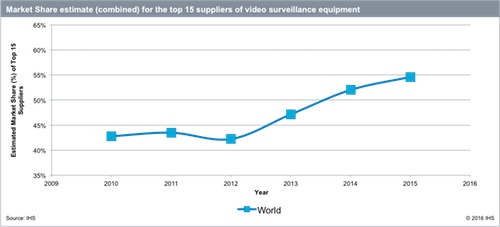
According to a recent research note from IHS Markit, the supply of video surveillance equipment is becoming more concentrated, however, it?s not primarily the result of increased industry consolidation. In fact, the research note states that this increased supply concentration is mainly due to companies taking market share from their competitors rather than through mergers and acquisitions.
In a research note, Niall Jenkins, Senior Manager, Video Surveillance at IHS Technologies, said that 2013 was pivotal year for the industry as not only did predictions of market concentration begin to become a reality but it was also the year that the top 15 video surveillance equipment suppliers jumped 10 percentage points over the previous year?s share. Essentially, Jenkins said 2013 marked a point where the market finally started to mature.
Outlook and Analysis
The year 2013 was a pivotal one for the video surveillance industry, because it was when predictions of market concentration started to become a reality. It was also when the estimated market share of the top 15 video surveillance equipment suppliers jumped 10 percentage points over the previous year?s share. In short, 2013 was when the video surveillance market finally started to mature.
But that is not the whole story.
Supply was —and is— becoming more concentrated, but it was not primarily the result of the many acquisitions the industry has experienced in recent years. As significant as they might be to the future of the industry, the acquisitions of Axis Communications and Milestone Systems by Japanese multi-national company, Canon, had little effect on the combined revenue share of leading vendors. In fact, the organic revenue growth of Chinese supplier, Hikvision, had more of an effect on making supply more concentrated in 2015. Despite the increase in merger and acquisition activity, increased supply concentration has been caused by companies taking market share from competitors, rather than by acquiring it through mergers.
The established realities of the market are also changing, as best-of-breed product suppliers are being challenged by solution providers offering pre-integrated products. Integrators are increasingly leveraging single-vendor solutions to reduce installation costs and focus on the more profitable service and maintenance contracts. Security camera shipments are booming, forecast to exceed 100 million units in 2016, but annual revenue growth has slowed to low single-digit rates. A war of attrition is being waged over the more price-sensitive markets.
In spite of the price pressure and hyper-competitive landscape of the last few years, the competitive landscape has not changed as much as one might expect. According to the latest annual market share analysis from IHS Markit, 11 of the same companies have remained in the top 15 ranking of video-surveillance equipment suppliers from 2010 to 2015. The companies gaining market share are no longer the new kids on the block, they are incumbents and leaders in the market.
The next chapter
The video surveillance market is changing. In price-sensitive markets, like the retail and commercial sectors, price is king and margins are low. Western vendors are exiting these markets, unsure of how to make the margins necessary to sustain their businesses. The high-end value-added markets, where functionality, reliability and performance are critical, are getting crowded. This is the battleground where the majority of video surveillance equipment vendors will either triumph or exit the market altogether.

